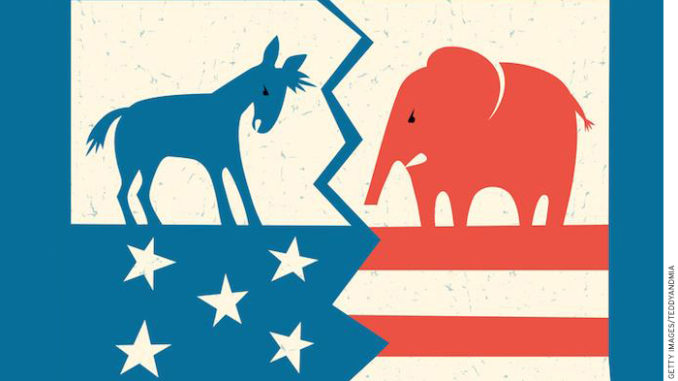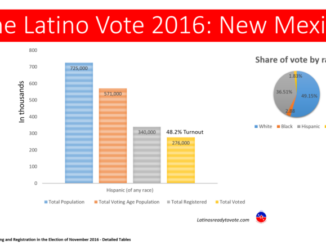
by Alex Gonzalez
The Texas Secretary of of State November Voter Registration report shows that the state is losing voters. The official count is at 13,988,920 registered voters. But in November of 2014, the record showed a total number of registered voters at 14,025,441. The state lost about 27,000 registered voters in one year while the voting age population increased to almost 19 million.
I made this table to show how voter registration has changed in the top 15 most populated counties in the state. In four big counties in South Texas – El Paso, Cameron, Nueces and Hidalgo – the number of registered voter has actually dropped to number lower than in 2014. Travis County also lost about 550 voters. These are counties that tend to vote Democrat.
 Traditionally, these 15 counties combined hold about 70% of the total turnout in the state.
Traditionally, these 15 counties combined hold about 70% of the total turnout in the state.
Moreover, this table shows that turnout in very conservative counties like Tarrant is about 10% higher on average than counties like Bexar and South Texas that are heavily Latino and lean Democrat. In 2012, all major four major Hispanic counties in South Texas had turnout in the low 50% and mid 40% while the very conservative counties like Collin and Denton had a turnout of low 60% to mid 60% in 2012.
 Most likely this will create problems for Democrats because not only Latinos and young Texans tend to have lower turnout than white seniors but also because new registration numbers from heavily populated Latinos counties show voter registration is stagnant and in some cases, they may be losing voters.
Most likely this will create problems for Democrats because not only Latinos and young Texans tend to have lower turnout than white seniors but also because new registration numbers from heavily populated Latinos counties show voter registration is stagnant and in some cases, they may be losing voters.
The slim increase in voter registration in conservative counties like Tarrant, Denton, Collin, Montgomery, Fort Bend could be attributed to the population growth in the suburbs of Dallas, Houston, Austin and San Antonio where middle-class families are looking for affordable housing and betters schools.
Too often, Democrats blame voter ID laws for low turnout among “minorities,” and albeit the conservative 5th Circuit Court of Appeals ruled that the Texas voter ID law has a “discriminatory effect,” the real problem with Latinos, other “minorities” and young voters in Texas is pure apathy.
There is also argument made by Mark Jones from Rice University suggesting that the state Voter ID law might have been the reason why 2,400 registered voters did not vote in 2014 in CD-23 where Rep. Will Hurd defeated Pete Gallegos. In the research Jones points out that:
“Researchers surveyed 400 people who registered but did not vote in the 29-county district, which stretches from San Antonio to El Paso and along a large slice of the Texas-Mexico border. The study found that less than 3 percent lacked proper identification during November’s election.” “The voter ID law depressed turnout in the 2014 election, but it did so primarily through confusion, not through actually keeping people without IDs from voting….13 percent of those registered in the 23rd Congressional District and did not vote stayed home, at least partly because they thought they lacked proper ID under a state law considered the strictest in the nation. And nearly 6 percent did not vote primarily because of the requirements.”
So whether or not “confusion” discouraged” 13 percent to stayed home”, it is still does not address the fact why in 2014 only 19.73% of registered voter in El Paso county vote – county covered under CD-23. Mr. Jones argues that this is important because CD-23 is a very competitive district and 2,400 voter made the differences between the winner and losers. However, in the original intent of the law, as ruled by the 5th Circuit was to have a “discriminatory affect,” is this effect only working in competitive districts, which in Texas there is only 12, as Ross Ramsey points out. So I don’t buy Jones’ argument.
Jones argue that “13 percent of those registered in the 23rd Congressional District did not vote stayed home” due to confusion, but the voter registration show that about 68% of the district did not vote.
According to the Texas SOS records show that Just 115,429 voted in CD-23 in 2014; 55,409 came from Bexar County, 6,924 From El Paso County, 9,807 from Medina County, 7,147 from Val Verde, 5,064 from Uvalde, and 2,947 from 2,947 Brewster County. These counties alone made about 85% of the total turnout of 115,429 in CD-23.
But, if we look at turnout in Bexar County it was only 31%, in El Paso County it was 19.73%, in Medina it was 34%, Val Verde int was 26%, in Uvalde it was 30%, and Brewster County turnout was 40%. And again, these counties are where about 85% of the votes for CD-23 came from. What these numbers show is that there is a characteristic in the entire district, a dismal turnout. And this problem could be related more to voter apathy than any voter ID law. This is a Congressional district where 60% of registered voter are Hispanic but only about 32% of registered voters cast a ballot in 2014.
Moreover, Most of those big Hispanic counties in South Texas that are not competitive have not reported voters being “discouraged” due to “confusion” created by the Voter ID law.
So regardless of what the state does to remedy this “confusion,” and make the law less “discriminatory” to comply with ruling of the 5th Circuit, the real problem with Latino voters in big metro areas and South Texans is still a self-inflicted wound – apathy – that cannot be remedied with federal or state bureaucracies. The new voter registration is a dismal sign of this apathy.
Alex Gonzalez is a political Analyst and Political Director for Latinos Ready To Vote. comments to [email protected]



